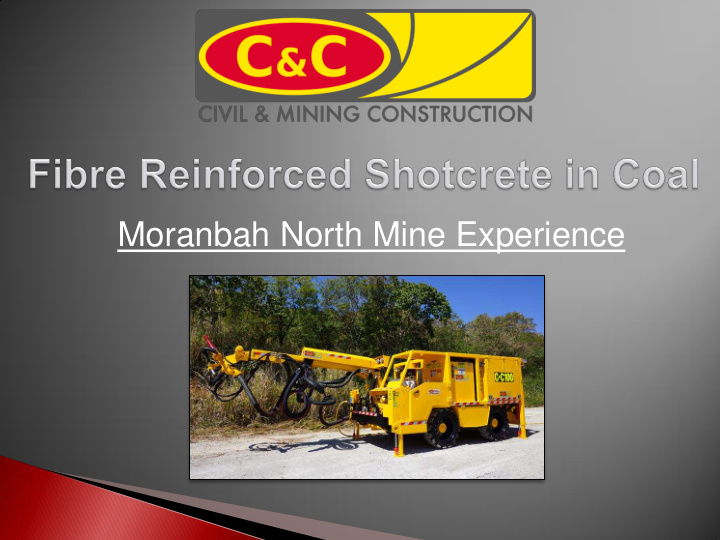



Moranbah North Mine Experience
C&C - Anglo (Moranbah North Mine) Shotcreting Project • Commenced with M&M drift repair in 2012 • Since 2012 Anglo has utilised the application of Fibre Reinforced Shotcrete (FRS) as part of innovative day to day mining operations including: • Secondary Support as an alternative to mesh & bolt • Strata Rehabilitation Works • Ventilation Control Devices • Gas migration control • UG Roadway pavements • Overcasts – Underpasses • Rib support to key infrastructure areas • Drainage Sumps • Tailgate and Bleeder Road Rib Support
MNM – Alternative Secondary Support System using FRS • Standard rib mesh bolting pattern at MNM is 3 x 1.8m bolts per m with rib mesh to approximately 2.0m • Alternative is to apply 75mm thick layer of FRS to full roadway height 3.7m • Cost saving approximately 30% per Lm • FRS is robust and provides rib protection from damage via mobile equipment – additional savings from reduced rework - remediation • Coal strata is sealed and does not fret overtime and bag out behind mesh – additional savings from reduced rework - remediation
FRS - Rib Support at MNM
UG Intersection Rib Support with FRS at MNM
MNM – Use of FRS to prevent oxygen Ingress & control rib gas emissions • MNM have utilised FRS to prevent oxygen ingress into sealed areas and to repair leaking seals • In MG111 as the continuous miner was at 12CT in gate road development, the rib emissions were such that the GB Methane concentration was 0.7% - 0.8%. Combined with the chain pillar ribs in the travel road created very poor intake. • FRS was applied to ribs from 4CT to 10CT as the CM advances such that when the CM was at 18CT the methane concentration was down to 0.2% GB. • FRS has proven vert effective at controlling gas migration at MNM. C&C have also tested these field results with laboratory panels to validate mine site experience.
MNM – FRS utilised to assist LW operations • Issue in LW110 where the block-side rib in the TG was failing ahead of the LW. This was causing roof failure above the TG shield. Each time the cavity was pumped with Rocsil Foam and the LW moved forward, the block-side rib would fail and cavity would extend forward. • Decision was made to shotcrete the rib with FRS in from the face to approximately 20m at approximately 100mm thick (roof to floor). Activator was increased to reduce strength gain time. • The LW started up and the rib held. Roof cavity didn’t propagate! • FRS normally used at MNM for walk-side rib support in the LW conveyor roadway. In LW602 MNM have used FRS to support the walk-side rib in the conveyor road. • Ribs also shotcreted in pump station CT for the LW to ensure operators are not exposed to falling ribs in the confines around the LW pump station
MNM – Change Management Information Process • MNM – C&C conducted information sessions for the workforce that explained the FRS application and how it was to be used for strata support. • Workforce was encouraged to ask questions about system. • More detailed sessions were conducted for mine officials to train them on inspection methods after application and over the lifetime of the support. • Sessions provided stakeholders with information on how and why the FRS system was being implemented and information on how to monitor once installed as a ground support tool • The workforce at MNM have embraced and fully supported FRS use as a ground support system at the mine.
VCD Construction with FRS
C&C Quality Assurance of FRS at MNM • C&C undertake weekly testing of FRS to confirm compliance including: Round Determinate Panels Cast Compressive Strength Cylinders Cored Compressive Strength Cylinders • Application depth controlled by installation of depth pins • Preparation of ribs – mesh prior to FRS application critical • FRS mix quality controlled via project QMP with all raw materials tested to AS • Safe Re-entry into areas where roof sprayed controlled by needling with meyco penetrometer
Recommend
More recommend